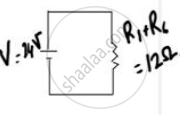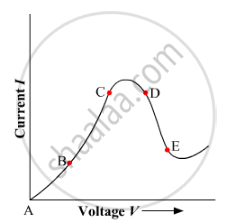Advertisements
Advertisements
Question

Calculate the total resistance of the circuit and find the total current in the circuit.
Solution


R3 and R4 are in series, hence the equivalent resistance of those two = R5 = R3 + R4 = 10 ohms
R5 and R2 are in parallel, Let R6 be the equivalent resistance for them. Hence R6 = (R5 × R2)/(R5 + R2) = 100/20 = 5 ohms
Now R1 and R6 are in series and hence the final equivalent resistance of the entire circuit is R = R1 + R6 = 12 ohms
By Ohm's Law we know that V = IR, hence I = V/R.
Hence the current in the circuit is 24/12 A = 2A
APPEARS IN
RELATED QUESTIONS
If the potential difference across the ends of a conductor is 220 V and the resistance of the conductor is 44 Ω (ohm), then the current flowing through is _________.
- 0.2 A
- 0.5 A
- 2 A
- 5 A
Graph showing the variation of current versus voltage for a material Ga As is shown in the figure. Identify the region of
(i) negative resistance
(ii) where Ohm's law is obeyed.

The relationship between the potential difference and the current in a conductor is stated in the form of a law.
1) Name the law.
2) What does the slope of V-I graph for a conductor represent?
3) Name the material used for making the connecting wire.
Write the formula of resistivity
Keeping the p.d. constant, the resistance of a circuit is halved. The current will become:
(a) one-fourth
(b) four time
(c) half
(d) double
State Ohm’s law and draw a neat labelled circuit diagram containing a battery, a key, a voltmeter, an ammeter, a rheostat and an unknown resistance to verify it.
Calculate the current flowing through a wire of resistance 5 Ω connected to a battery of potential difference 3 V.
Tick(✓) the correct choice in the following:
Ohm's law is applicable to
Define temperature coefficient of resistance.
Why should an ammeter have low resistance?
